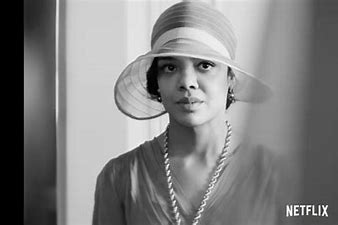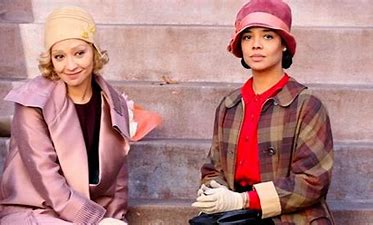Tessa Thompson and Ruth Negga are Superb in Rebecca Hall’s directorial debut.
You cannot take your eyes off Ruth Negga’s Claire, a Black woman who can pass for White in New York in the fading days of The Roaring Twenties. Not only can she pass for White, but she lives as a White woman married to a racist White man (Alexander Skarsgard) and has a daughter who, thank the lord, was born White enough not to raise any suspicions.

Irene (Tessa Thompson)
Then there is Irene (Tessa Thompson), who can also pass but is slightly darker than Claire and has decided to live as a Black woman. A cultured middle-class Black woman married to a Black doctor (Andre Holland), has two handsome young boys, and lives in a lovely Harlem brownstone. It was a time of astonishing Black creativity, the Harlem Renaissance. Yet, from the first moment we meet her, we feel that something is missing from Irene’s life.
The Hottest Day of the Year.
It’s a scorching summer afternoon. It’s 1929, and Irene has ventured out of Harlem into White New York to shop. People are dropping like flies all around her, so she decides, as she does occasionally, to “pass.” She will cool off with a cold drink in one of those gorgeous but “White-Only” Art Deco hotels that line Central Park and Park Avenue. She likes to wear wide-brimmed hats, which help her pull off this ruse and boost her confidence. The hat divides her head in two, a vaguely cubist look, and she is always looking out under the brim like Bette Davis in” Now Voyager.”

Air-Conditioned Heaven
The ruse works, and she enters a magnificent, air-conditioned lounge where the well-appointed patrons (remember, this is the summer before the crash) pay her no notice, and the staff treats her well, like a White person. Sitting in the audience, we feel like Irene. We feel like we have entered Heaven. And in this Heaven, Irene sees a vision. She is a woman of such beauty and grace that she and the audience are in a delicious trance. And the woman is staring straight at her and smiling. The woman then rose from her chair and appeared to be leaving, but she was headed for Irene, who was utterly baffled. Irene does not recognize that it is her old friend Claire from high school who, granted, has undergone a few changes, like dying her hair peroxide blond.
Take My Breath Away
The opening sequence of writer/director Rebecca Halls’s directorial debut, “Passing,” is so beautifully directed and photographed (Eduard Grau is the cinematographer, and the lensing is in black and white or, more accurately, a thousand shades of grey), and acted that, at times, it takes your breath away. In many ways, it is the highlight of the film.

Claire’s Harlem Renaissance.
Claire invites Irene up to her hotel room, where they have a drink, and Irene meets Claire’s husband, who, not knowing that she is Black, makes a couple of racist statements. Despite this, Irene stays for the afternoon, and as she leaves, Claire asks her if she can visit her and immerse herself in the Harlem nightlife as a Black woman. Irene is reluctant at first. For all the admiration, something is overwhelming and smothering about Claire and an unnamed attraction. And there is also Irene’s own life and the choices that she has made.
Carl Van Vechten.
There is one great scene at a party where the cream of Harlem plays Jazz and dances. By this time, many White people, knowing that all the best and most innovative Jazz was coming out of Harlem (like The Cotton Club), were frequent visitors. Irene is standing next to a famous gay photographer (Bill Camp being deliciously, well, camp) modeled on the photographer Carl Van Vechten. Her astute and witty observations give us a window into a different Irene, an Irene who, at another time, could have been a writer for Vanity Fair or The New Yorker.

Claire vs. Irene.
Although Negga gets all of the film’s high points, it’s Thompson’s story. We see the movie through Irene’s eyes, and Thompson is devastatingly good. We gradually realize that Claire and Irene are different sides of the same coin: both are examples of the fact that it is often the things you give up as you claw your way up life’s ladder that turn out to be most important.
Rebecca Hall.
Hall’s screenplay removes some of the opening chapters of Nella Larsen’s 1929 novel, which streamlines the story, and her direction never falters on the way to its ferocious and ambiguous ending. Essential Viewing.
NOW STREAMING ON NETFLIX.
65 Queer Films Made Under the Hays Code (1934-1967) Part One. – TheBrownees
65 Queer Films Made Under the Hays Code (1934-1967). Part Two. – TheBrownees
65 Queer Films Made Under the Hays Code (Table) – TheBrownees
45 Queer Films from 1967-1976: Queer Cinema Comes Out – TheBrownees


















